Irradiation-Assisted Microstructure Evolution and Mechanical Properties Loss of 310S Welded Joints
Abstract
:1. Introduction
2. Experiment
2.1. Specimen Preparation and Heat Treatments
2.2. Irradiation Experiments
2.3. Tensile and Creep Tests
3. Experimental Results and Analysis
3.1. Tensile Property
3.2. Creep Property
3.3. Nano-Indentation Test
3.4. APT Analysis
3.5. Microstructures of Welded Joints
3.5.1. Microstructural Evolution of Welded Joints
3.5.2. Irradiation-Induced Cracking Behavior
4. Conclusions
- (1)
- The elongation and creep properties decreased for irradiation specimens, especially the elongation reduction reaching about 5%, and the creep fracture deformation value was reduced to 70% that of un-irradiated specimens by 60Co. The specimens of mechanical properties revealed recovery for irradiated specimens by the accelerator;
- (2)
- The 60Co irradiated specimens had the highest Nano-indenter hardness, especially the hardness of base metal was 5.9 GPa, 44% higher than the unirradiated specimens. On the other hand, the indenter hardness decreased after the accelerator irradiation;
- (3)
- The irradiation-induced Cr, C and P enrichment at the phase boundaries for 60Co irradiation specimens. After further accelerator irradiation, the degree of element segregation is further intensified; the width of the Cr transition at both boundaries was increased from 6 nm to 7.5 nm;
- (4)
- Based on element segregation analysis, irradiation-induced element segregation forms rich Ni and Si enrichment and Cr depletion at grain boundaries and precipitates. Under the action of continuous tensile stress, cavity defects are easily formed between M23C6 carbide and the non-coherent austenite matrix. The growth of cavities will accumulate the intergranular cracks nucleation, leading to intergranular fracture for welded joints.
Author Contributions
Funding
Data Availability Statement
Acknowledgments
Conflicts of Interest
References
- Kearney, S.; Yorkshire, A.S.; Geddes, D.A.; Hanein, T.; Nelson, S.; Provis, J.L.; Walkley, B. Chapter 25—Cement-based stabilization/solidification of radioactive waste. In Low Carbon Stabilization and Solidification of Hazardous Wastes; Tsang, D.C.W., Wang, L., Eds.; Elsevier: Amsterdam, The Netherlands, 2022; pp. 407–431. [Google Scholar]
- Tan, S. Chapter 26—Glass-based stabilization/solidification of radioactive waste. In Low Carbon Stabilization and Solidification of Hazardous Wastes; Tsang, D.C.W., Wang, L., Eds.; Elsevier: Amsterdam, The Netherlands, 2022; pp. 433–447. [Google Scholar]
- Lo, K.H.; Shek, C.H.; Lai, J.K.L. Recent developments in stainless steels. Mater. Sci. Eng. R Rep. 2009, 65, 39–104. [Google Scholar] [CrossRef]
- Liu, Z.; Lu, J.; Su, H.; Long, J.; Li, L.; Wang, P.; Cong, S.; Ma, Z.; Zhang, L.; Guo, X. On the role of mechanical deformation in the environmental degradation of 310S stainless steels in supercritical carbon dioxide. Corros. Sci. 2022, 207, 110537. [Google Scholar] [CrossRef]
- Ustrzycka, A. Physical Mechanisms Based Constitutive Model of Creep in Irradiated and Unirradiated Metals at Cryogenic Temperatures. J. Nucl. Mater. 2021, 548, 152851. [Google Scholar] [CrossRef]
- Paccou, E.; Tanguy, B.; Legros, M. Irradiation-assisted stress corrosion cracking susceptibility and mechanical properties related to irradiation-induced microstructures of 304L austenitic stainless steel. J. Nucl. Mater. 2020, 528, 151880. [Google Scholar] [CrossRef]
- Jepeal, S.J.; Danagoulian, A.; Kesler, L.A.; Korsun, D.A.; Lee, H.Y.; Schwartz, N.; Sorbom, B.N.; Lopez, E.V.; Hartwig, Z.S. An accelerator facility for intermediate energy proton irradiation and testing of nuclear materials. Nucl. Instrum. Methods Phys. Res. Sect. B Beam Interact. Mater. At. 2021, 489, 41–49. [Google Scholar] [CrossRef]
- Fukuya, K.; Nishioka, H.; Fujii, K.; Kamaya, M.; Miura, T.; Torimaru, T. Fracture behavior of austenitic stainless steels irradiated in PWR. J. Nucl. Mater. 2008, 378, 211–219. [Google Scholar] [CrossRef]
- Kenik, E.A.; Busby, J.T. Radiation-induced degradation of stainless steel light water reactor internals. Mater. Sci. Eng. R Rep. 2012, 73, 67–83. [Google Scholar] [CrossRef]
- Chopra, O.K.; Rao, A.S. A review of irradiation effects on LWR core internal materials—Neutron embrittlement. J. Nucl. Mater. 2011, 412, 195–208. [Google Scholar] [CrossRef]
- Bosch, R.W.; Vankeerberghen, M.; Gérard, R.; Somville, F. Crack initiation testing of thimble tube material under PWR conditions to determine a stress threshold for IASCC. J. Nucl. Mater. 2015, 461, 112–121. [Google Scholar] [CrossRef]
- Wang, S.; Zhang, S.; Xie, J.; Feng, X.; Song, M.; Was, G.S.; Kuang, W. Clarifying the mitigation effect of proton irradiation on the intergranular oxidation of 316L stainless steel in high temperature water. Acta Mater. 2022, 241, 118408. [Google Scholar] [CrossRef]
- Liang, D.; Hure, J.; Courcelle, A.; El Shawish, S.; Tanguy, B. A micromechanical analysis of intergranular stress corrosion cracking of an irradiated austenitic stainless steel. Acta Mater. 2021, 204, 116482. [Google Scholar] [CrossRef]
- Féron, D.; Herms, E.; Tanguy, B. Behavior of stainless steels in pressurized water reactor primary circuits. J. Nucl. Mater. 2012, 427, 364–377. [Google Scholar] [CrossRef]
- Pokor, C.; Brechet, Y.; Dubuisson, P.; Massoud, J.-P.; Averty, X. Irradiation damage in 304 and 316 stainless steels: Experimental investigation and modeling. Part II: Irradiation induced hardening. J. Nucl. Mater. 2004, 326, 30–37. [Google Scholar] [CrossRef]
- Wang, M.; Song, M.; Lear, C.R.; Was, G.S. Irradiation assisted stress corrosion cracking of commercial and advanced alloys for light water reactor core internals. J. Nucl. Mater. 2019, 515, 52–70. [Google Scholar] [CrossRef]
- Gussev, M.N.; McClintock, D.A.; Lach, T.G. Origin, parameters, and underlying deformation mechanisms of propagating deformation bands in irradiated 316L stainless steel. Acta Mater. 2023, 242, 118434. [Google Scholar] [CrossRef]
- Fuller, R.W.; Simsiriwong, J.; Shamsaei, N. Crack growth prediction for irradiated stainless steels under the combined fatigue-creep loading. Theor. Appl. Fract. Mech. 2020, 109, 102759. [Google Scholar] [CrossRef]
- Aygün, B. High alloyed new stainless steel shielding material for gamma and fast neutron radiation. Nucl. Eng. Technol. 2020, 52, 647–653. [Google Scholar] [CrossRef]
- Kumar, P.; Soni, R.K.; Dehiya, B.S.; Sivakumar, V.V. Study of phase changes induced by gamma irradiation in welded stainless steel alloys 304 and 316. Mater. Today Proc. 2021, 47, 6545–6550. [Google Scholar] [CrossRef]
- Aygün, B. Neutron and gamma radiation shielding Ni based new type super alloys development and production by Monte Carlo Simulation technique. Radiat. Phys. Chem. 2021, 188, 109630. [Google Scholar] [CrossRef]
- Hoffman, A.K.; Zhang, Y.; Arivu, M.; He, L.; Sridharan, K.; Wu, Y.; Islamgaliev, R.K.; Valiev, R.Z.; Wen, H. Novel effects of grain size and ion implantation on grain boundary segregation in ion irradiated austenitic steel. Acta Mater. 2023, 246, 118714. [Google Scholar] [CrossRef]
- Li, C.; Chen, F.; Ge, G.; Lin, J.; Sun, Z.; Fan, M.; Huang, P.; Tang, X. Impact of sub-grain structure on radiation resistance in additively manufactured 316L stainless steels: An atomic insight into the mechanism. Appl. Surf. Sci. 2022, 606, 154926. [Google Scholar] [CrossRef]
- Eissa, M.M.; El-kameesy, S.U.; El-Fiki, S.A.; Ghali, S.N.; El Shazly, R.M.; Saeed, A. Attenuation capability of low activation-modified high manganese austenitic stainless steel for fusion reactor system. Fusion Eng. Des. 2016, 112, 130–135. [Google Scholar] [CrossRef]
- Medhat, M.E.; Wang, Y. Investigation on radiation shielding parameters of oxide dispersion strengthened steels used in high temperature nuclear reactor applications. Ann. Nucl. Energy 2015, 80, 365–370. [Google Scholar] [CrossRef]
- Obodovskiy, I. Chapter 29—Fundamentals of Radiation Materials Science. In Obodovskiy I. Radiation; Elsevier: Abingdon, UK, 2019; pp. 367–371. [Google Scholar]
- Jiang, B.; Liang, N.; Xu, L.; Gao, L.; Peng, Q.; Jiao, Z.; Chen, Y.; Li, W.; He, Y.; Wang, L. Combined effects of irradiation and hydrogen on the mechanical and corrosion performances of the ferrite in duplex phase steels. J. Nucl. Mater. 2022, 572, 154069. [Google Scholar] [CrossRef]
- Jiang, B.; Zhang, B.; He, Y.; Peng, Q.; Jiao, Z.; Qiao, L. Combined effects of irradiation and hydrogen ions on surface oxidation of 308 L austenite stainless steel. Corros. Sci. 2021, 191, 109734. [Google Scholar] [CrossRef]
- Lin, X.; Peng, Q.; Han, E.-H.; Ke, W. Deformation and cracking behaviors of proton-irradiated 308L stainless steel weld metal strained in simulated PWR primary water. J. Mater. Sci. Technol. 2022, 120, 36–52. [Google Scholar] [CrossRef]
- GB/T 228.1-2021; Metallic Materials—Testing Testing—Part 1: Method of Test at Room Temperature. Standards Press of China: Beijing, China, 2021.
- GB/T 2039-2012; Metallic materials—Uniaxial Creep Testing Method in Tension. Standards Press of China: Beijing, China, 2012.
- EN 10095; Heat Resisting Steels and Nickel Alloys. European Committee for Standardization: Berlin, Germany, 2018.
- Yang, W.-H.; Cheng, P.-M.; Li, Y.; Wang, R.; Liu, G.; Xin, L.; Zhang, J.-Y.; Li, D.-P.; Zhang, H.-B.; Sun, J. Dynamic strain aging-mediated temperature dependence of ratcheting behavior in a 316LN austenitic stainless steel. Mater. Sci. Eng. A 2023, 862, 144503. [Google Scholar] [CrossRef]
- Sauzay, M.; Bavard, K.; Karlsen, W. TEM observations and finite element modelling of channel deformation in pre-irradiated austenitic stainless steels—Interactions with free surfaces and grain boundaries. J. Nucl. Mater. 2010, 406, 152–165. [Google Scholar] [CrossRef]
- Byun, T.S.; Farrell, K.; Li, M. Deformation in metals after low-temperature irradiation: Part II—Irradiation hardening, strain hardening, and stress ratios. Acta Mater. 2008, 56, 1056–1064. [Google Scholar] [CrossRef]
- Fukumoto, K.I.; Mabuchi, T.; Yabuuchi, K.; Fujii, K. Irradiation hardening of stainless steel model alloy after Fe-ion irradiation and post-irradiation annealing treatment. J. Nucl. Mater. 2021, 557, 153296. [Google Scholar] [CrossRef]
- Van Renterghem, W.; Al Mazouzi, A.; Van Dyck, S. Influence of post irradiation annealing on the mechanical properties and defect structure of AISI 304 steel. J. Nucl. Mater. 2011, 413, 95–102. [Google Scholar] [CrossRef]
- Shin, J.H.; Kong, B.S.; Jeong, C.; Eom, H.J.; Jang, C.; Shao, L. Evaluation of radiation resistance of an austenitic stainless steel with nanosized carbide precipitates using heavy ion irradiation at 200 dpa. Nucl. Eng. Technol. 2023, 55, 555–565. [Google Scholar] [CrossRef]
- Zinkle, S.J.; Was, G.S. Materials challenges in nuclear energy. Acta Mater. 2013, 61, 735–758. [Google Scholar] [CrossRef]
- Sarkar, A.; Dash, M.K.; Nagesha, A.; Dasgupta, A.; Sandhya, R.; Okazaki, M. EBSD based studies on various modes of cyclic deformation at 923 K in a type 316LN stainless steel. Mater. Sci. Eng. A 2018, 723, 229–237. [Google Scholar] [CrossRef]
- Yang, W.-H.; Cheng, P.-M.; Li, Y.; Wang, R.; Liu, G.; Xin, L.; Zhang, J.-Y.; Sun, J. Ratcheting-induced twinning/de-twinning behaviors in a 316LN austenitic stainless steel. Mater. Sci. Eng. A 2022, 851, 143648. [Google Scholar] [CrossRef]
- Wang, Y.; Zhang, W.; Wang, Y.; Lim, Y.C.; Yu, X.; Feng, Z. Experimental evaluation of localized creep deformation in grade 91 steel weldments. Mater. Sci. Eng. A 2021, 799, 140356. [Google Scholar] [CrossRef]
- Stephenson, K.J.; Was, G.S. The role of dislocation channeling in IASCC initiation of neutron irradiated stainless steel. J. Nucl. Mater. 2016, 481, 214–225. [Google Scholar] [CrossRef]
- Jiao, Z.; Was, G.S. Localized deformation and IASCC initiation in austenitic stainless steels. J. Nucl. Mater. 2008, 382, 203–209. [Google Scholar] [CrossRef]
- Johnson, D.C.; Kuhr, B.; Farkas, D.; Was, G.S. Quantitative analysis of localized stresses in irradiated stainless steels using high resolution electron backscatter diffraction and molecular dynamics modeling. Scr. Mater. 2016, 116, 87–90. [Google Scholar] [CrossRef]
- McMurtrey, M.D.; Cui, B.; Robertson, I.; Farkas, D.; Was, G.S. Mechanism of dislocation channel-induced irradiation assisted stress corrosion crack initiation in austenitic stainless steel. Curr. Opin. Solid State Mater. Sci. 2015, 19, 305–314. [Google Scholar] [CrossRef]
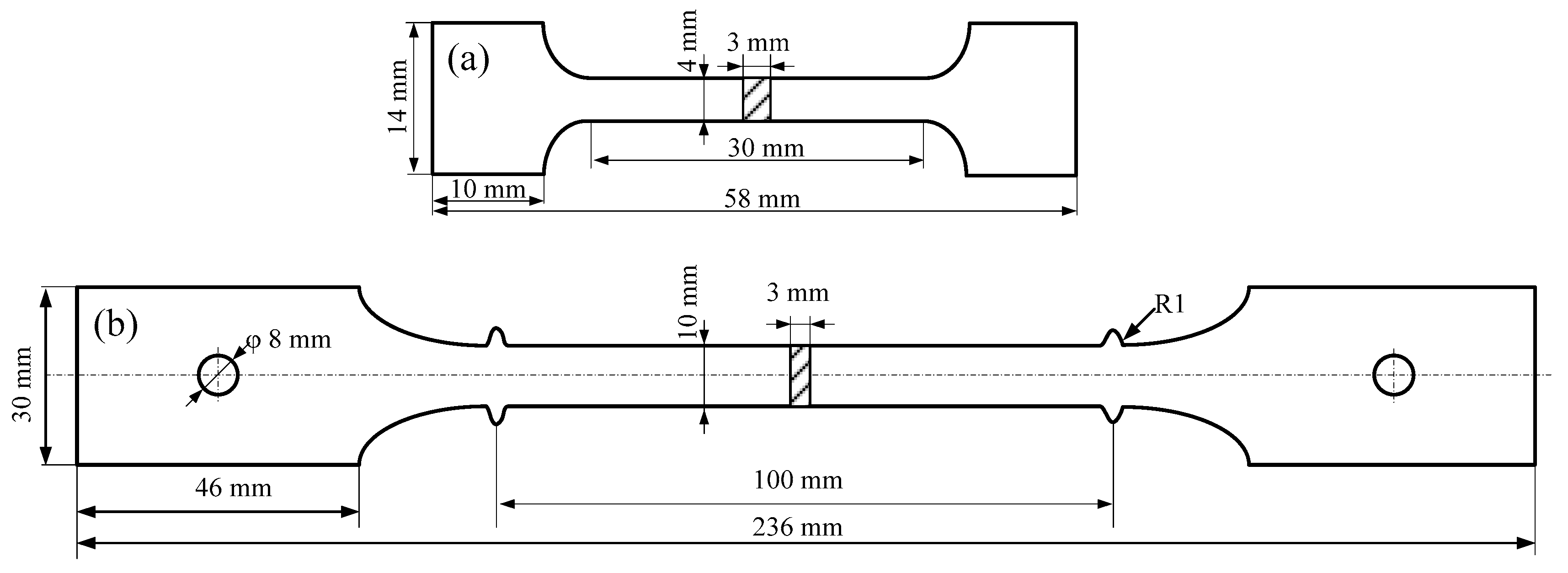
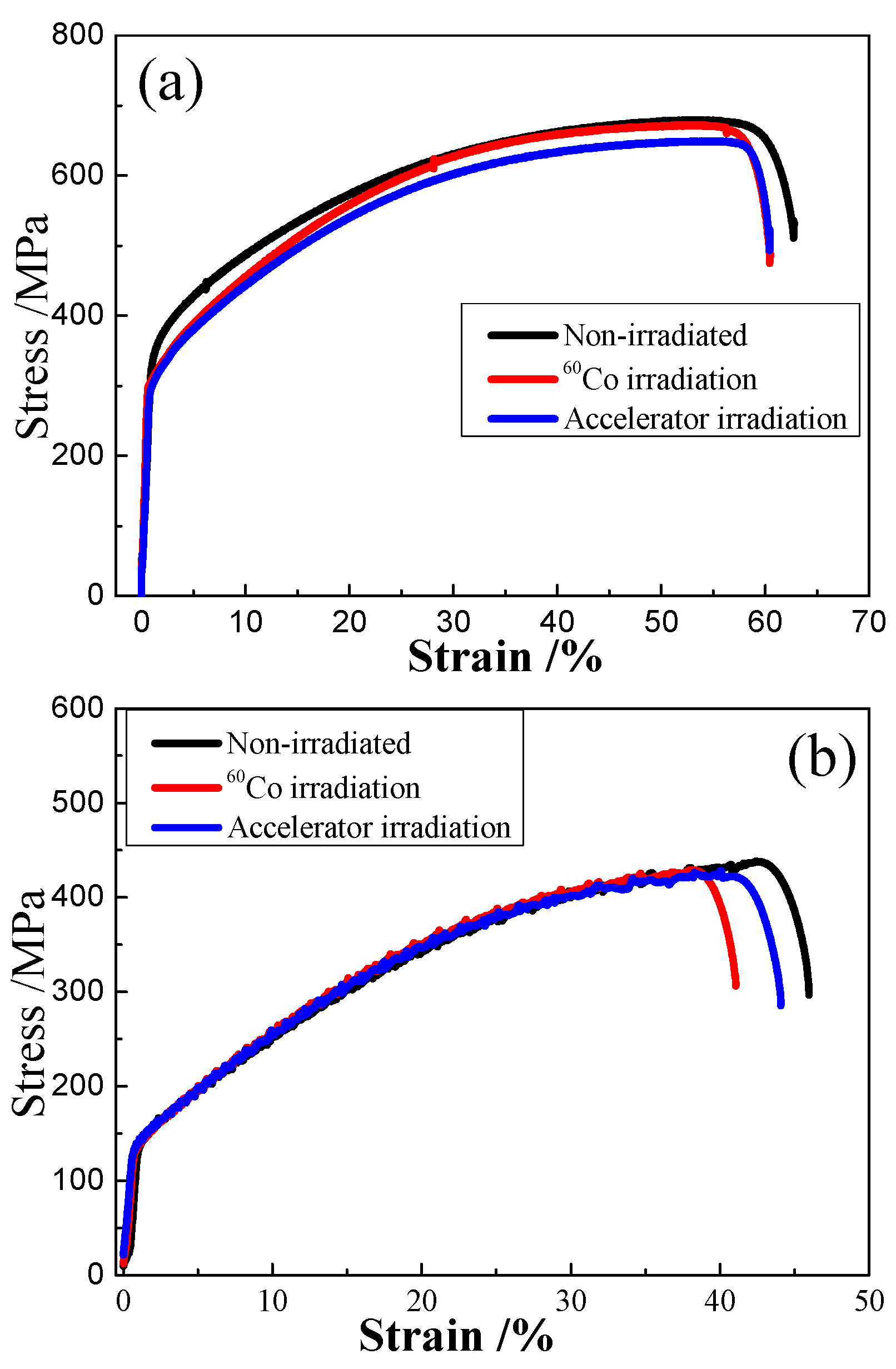
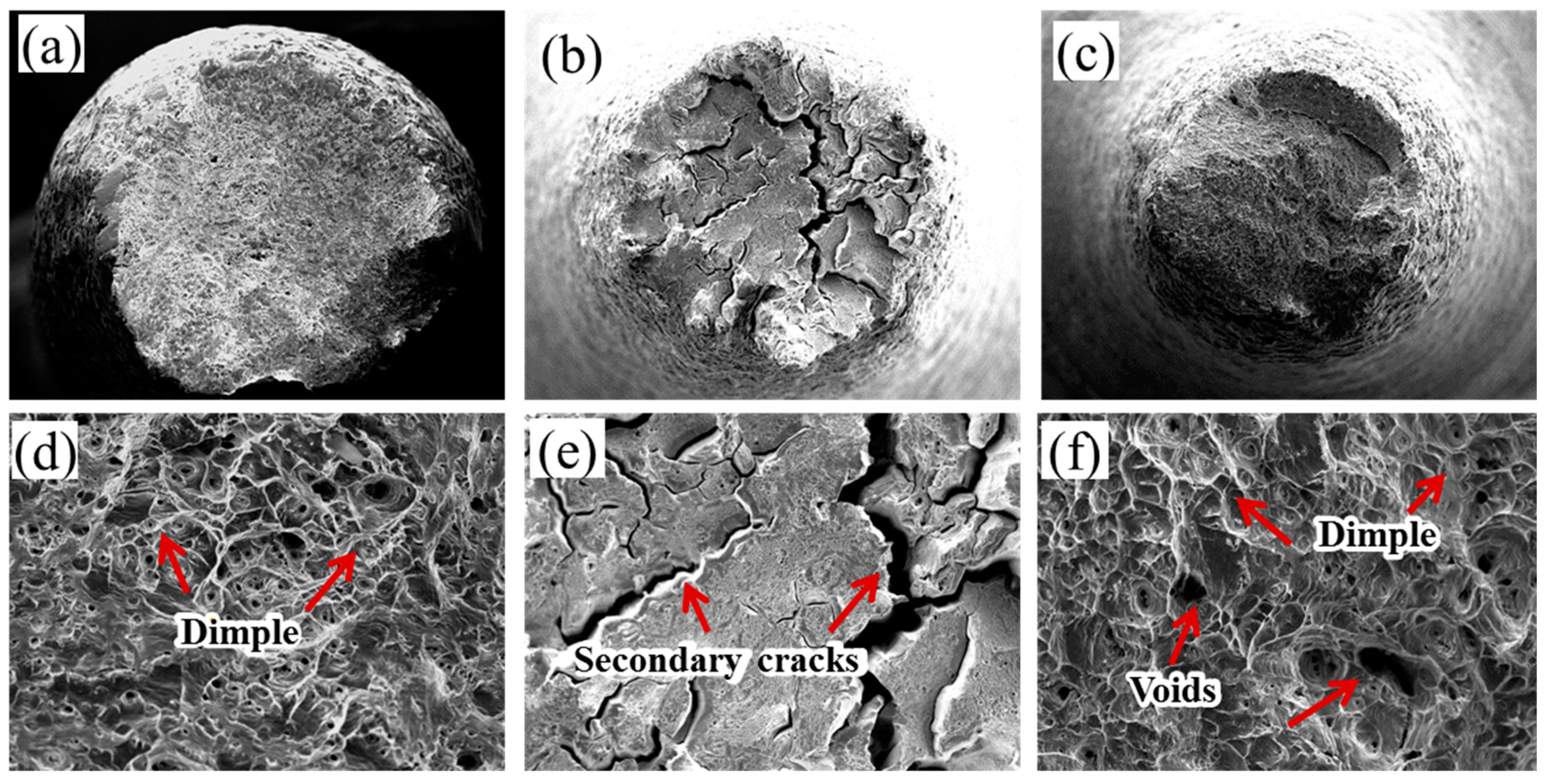





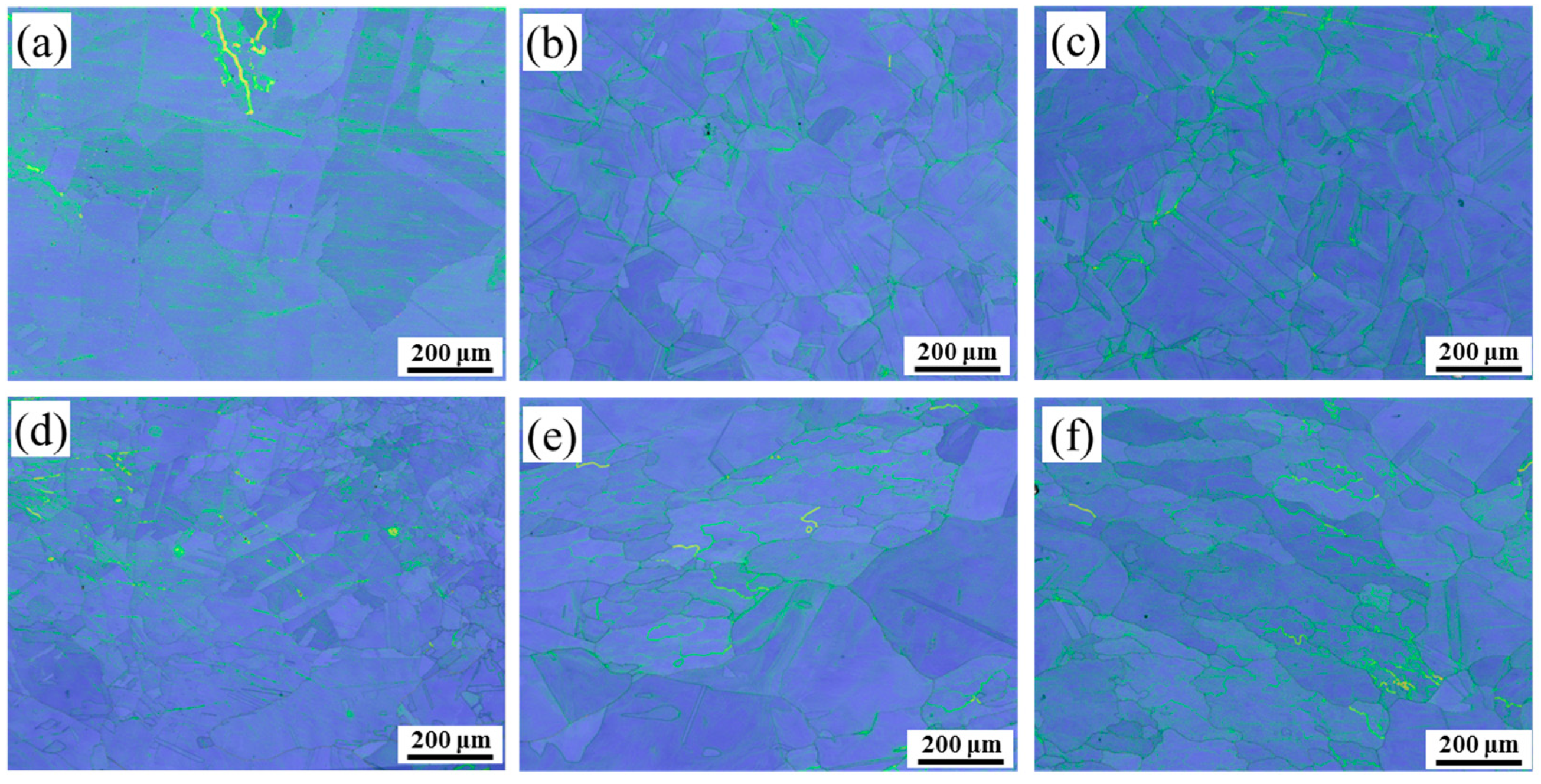

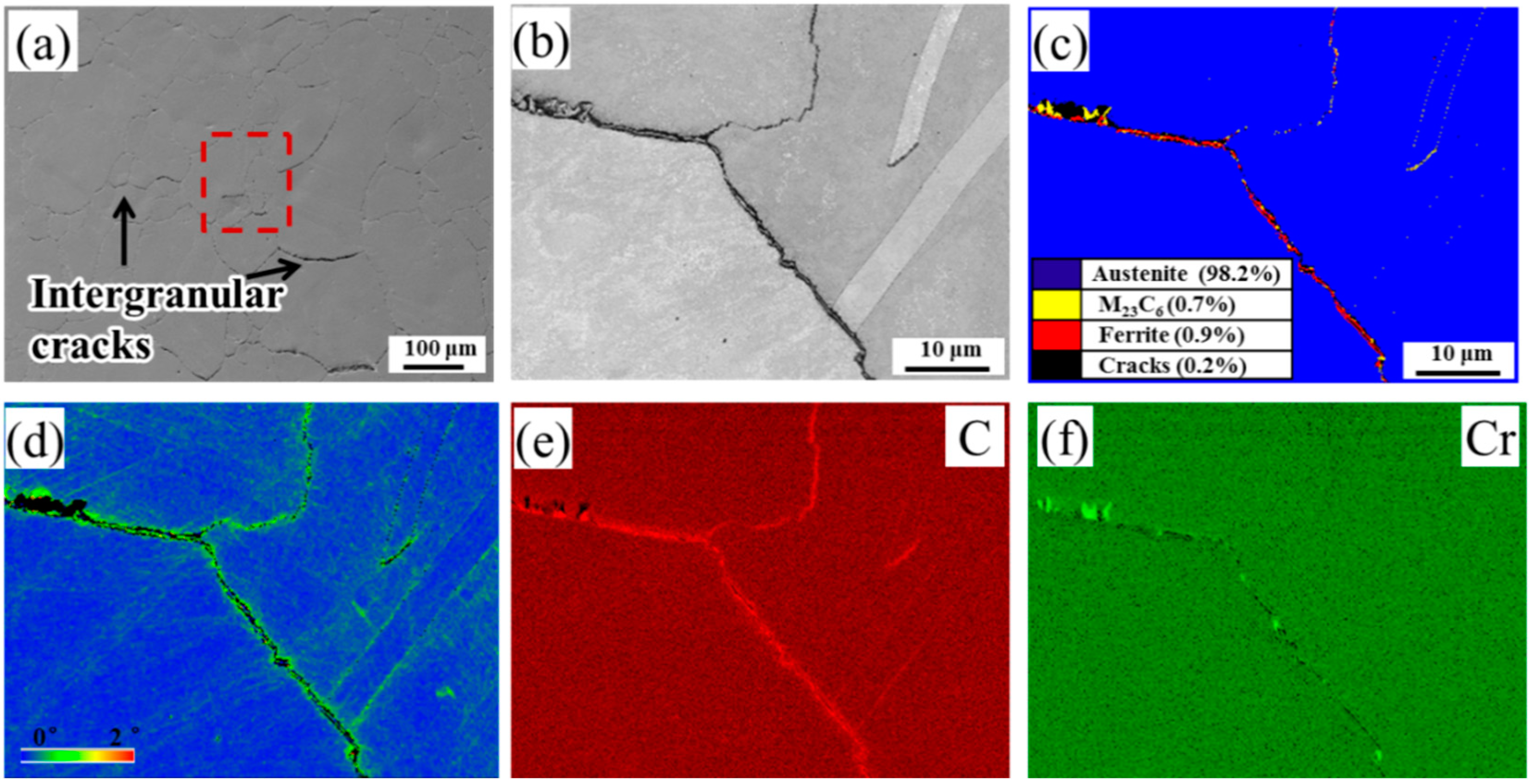
| Elements | C | Cr | Ni | Mn | Mo | Si | Co | Nb | N | Ce | Ta | Fe |
|---|---|---|---|---|---|---|---|---|---|---|---|---|
| BM | 0.10 | 20.5 | 11.1 | 2.0 | 0.05 | 2.20 | 0.10 | 0.03 | / | 0.04 | / | Bal. |
| Filler materials | 0.09 | 26.4 | 21.8 | 2.0 | 0.35 | 0.38 | 0.20 | 0.05 | 0.15 | / | 0.20 | Bal. |
| Welding Current (A) | Welding Voltage (V) | Welding Speed (mm/s) | Gas Flow Rate (L/min) | Groove Type | Groove Gap (mm) |
|---|---|---|---|---|---|
| 160 | 25 | 3 | 15 | I | 0–0.1 |
Disclaimer/Publisher’s Note: The statements, opinions and data contained in all publications are solely those of the individual author(s) and contributor(s) and not of MDPI and/or the editor(s). MDPI and/or the editor(s) disclaim responsibility for any injury to people or property resulting from any ideas, methods, instructions or products referred to in the content. |
© 2023 by the authors. Licensee MDPI, Basel, Switzerland. This article is an open access article distributed under the terms and conditions of the Creative Commons Attribution (CC BY) license (https://creativecommons.org/licenses/by/4.0/).
Share and Cite
Jiang, Y.; Kan, Y.; Wu, C.; Chen, H. Irradiation-Assisted Microstructure Evolution and Mechanical Properties Loss of 310S Welded Joints. Metals 2023, 13, 858. https://doi.org/10.3390/met13050858
Jiang Y, Kan Y, Wu C, Chen H. Irradiation-Assisted Microstructure Evolution and Mechanical Properties Loss of 310S Welded Joints. Metals. 2023; 13(5):858. https://doi.org/10.3390/met13050858
Chicago/Turabian StyleJiang, Yunlu, Ying Kan, Changzhong Wu, and Huaining Chen. 2023. "Irradiation-Assisted Microstructure Evolution and Mechanical Properties Loss of 310S Welded Joints" Metals 13, no. 5: 858. https://doi.org/10.3390/met13050858




